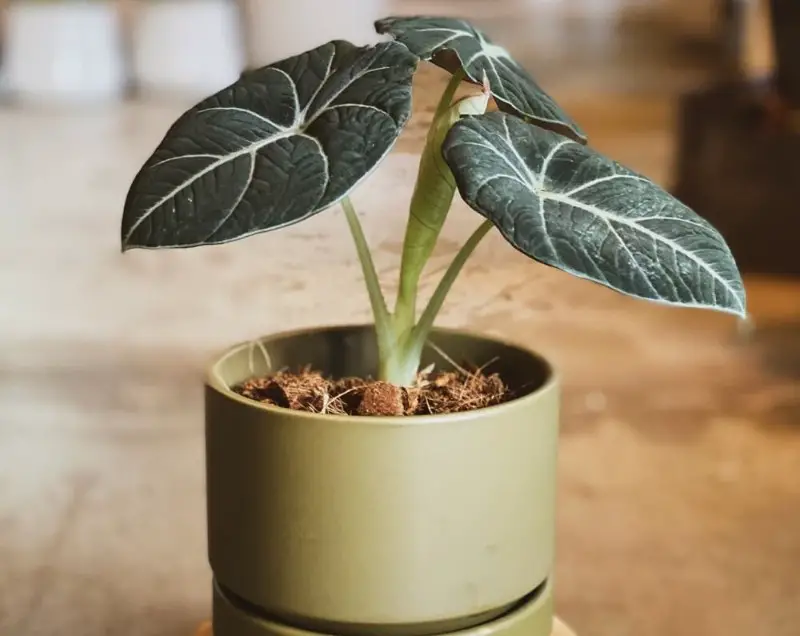Welcome to our comprehensive guide on caring for the stunning Alocasia Black Velvet, a plant celebrated for its striking, velvety leaves and unique appearance. This tropical gem, native to Southeast Asia, has become increasingly popular among indoor plant enthusiasts for its dramatic foliage and low maintenance requirements. However, to fully appreciate its beauty, understanding the specific care needs of Alocasia Black Velvet is essential.
In this detailed guide, we will explore everything you need to know about growing and maintaining this exquisite plant, including ideal lighting conditions, watering schedules, humidity levels, and common problems to watch out for.
About Alocasia Black Velvet

Alocasia Black Velvet, also known as Black Velvet Elephant Ear, is a striking plant belonging to the Araceae family. Its botanical name is Alocasia reginula A. Hay, and it is a herbaceous perennial plant that grows up to 1.5 feet tall. Native to Southeast Asia, it thrives in partial sunlight and prefers well-drained soil with an acidic to neutral pH.
Although it rarely blooms, when it does, it produces small white flowers. This plant is suitable for USDA hardiness zones 10 and above. However, it is toxic to both humans and pets, so caution is advised when handling or placing it in your home.
Alocasia Black Velvet Care
Alocasia Black Velvet requires specific care to thrive. It should be planted in a pot with loose, well-draining soil to prevent waterlogging. The plant prefers warm, bright, and humid environments, making it ideal for indoor spaces with indirect light.
Water it thoroughly about once a week, ensuring excess liquid drains out. While it is a slow-growing plant, with proper care, it will reward you with its unique, velvety foliage.
Light for Alocasia Black Velvet
Alocasia Black Velvet thrives in bright but indirect light, much like the natural conditions of a tropical jungle floor. Unlike larger Alocasia varieties that can tolerate full sun, Black Velvet prefers dappled light to maintain its signature velvety foliage. Positioning it near a north or east-facing window is ideal, as it allows for gentle morning light that isn’t too harsh.
Exposure to too little light can lead to leggy, weak stems and dull, faded leaves, reducing the plant’s visual appeal. For vibrant growth and healthy foliage, providing the right light balance is essential when caring for your Alocasia Black Velvet.
Soil for Alocasia Black Velvet
To keep Alocasia Black Velvet healthy, even moisture is crucial, which means using a loose, well-drained potting mix. Since root rot is a common issue with this plant, choosing a tropical soil blend containing bark, sand, and loam ensures proper drainage.
Avoid mixes that are too high in absorbent materials like peat moss or coco coir, as they retain too much moisture and can lead to waterlogged roots. A well-balanced soil mixture will promote healthy growth and prevent common soil-related problems.
Watering Alocasia Black Velvet
Proper watering is crucial for the health of Alocasia Black Velvet, as overwatering is one of the most common causes of plant failure. These plants should never be left sitting in water, as it can quickly lead to root rot. While they do appreciate regular watering, especially during the growing season, it’s important to water deeply, allowing the soil to soak up moisture, and then drain any excess water immediately. To avoid overwatering, wait until around 20% of the topsoil has dried out before watering again.
Unlike larger Alocasia varieties, Black Velvet doesn’t require as frequent watering, so it’s important not to treat it the same as its bigger cousins. A useful tip is to place the pot on a tray filled with water and pebbles. This setup allows the plant to enjoy the necessary humidity without exposing its roots to standing water, which can lead to the dreaded “wet feet.”
During the winter months, watering should be significantly reduced. Alocasia Black Velvet enters a semi-dormant state, so the soil can be allowed to dry out more between waterings. The plant still needs moisture, but less frequently, as its growth slows down in cooler temperatures. Adapting your watering habits to the seasonal changes will help keep your plant thriving year-round.
Temperature and Humidity for Alocasia Black Velvet
Alocasia Black Velvet, being a tropical plant, thrives in warm temperatures and high humidity. To maintain its health, you should avoid exposing it to drafty, cold environments or dry, air-conditioned rooms, as these conditions can stress the plant. Ideally, the humidity should be kept above 50 percent, and during drier months or in cooler climates, you may need to take additional steps like misting, using a pebble tray, or placing a humidifier nearby. For those looking to provide an optimal environment, growing the plant in a terrarium is an excellent option, especially during winter.
This plant performs best when temperatures remain above 70°F, although it can tolerate cooler temperatures as low as 60°F. However, prolonged exposure to colder temperatures may stunt growth or cause stress.
Fertilizer for Alocasia Black Velvet
When it comes to fertilizing Alocasia Black Velvet, less is often more. While this slow-growing plant won’t suddenly speed up its growth with heavy feeding, it can benefit from a regular but light fertilizing schedule. During the growing season, which typically spans spring and summer, feed the plant every two weeks to once a month using a balanced liquid houseplant fertilizer. This gentle feeding routine helps support its growth without overwhelming the plant.
Unlike larger Alocasia varieties, Black Velvet doesn’t always require supplemental feeding, and over-fertilizing can lead to issues like root burn or salt buildup in the soil. Therefore, it’s essential to follow a moderate feeding plan, ensuring the plant gets the nutrients it needs without overdoing it. During the fall and winter months, when the plant’s growth slows, you can pause fertilizing altogether.
Pruning Alocasia Black Velvet
Pruning Alocasia Black Velvet is a straightforward task, as this plant doesn’t have demanding pruning requirements. However, it’s essential to regularly trim away any dead or dying foliage, even on the healthiest mature plants. This practice allows the plant to focus its nutrients on producing new leaves, promoting healthier growth.
Additionally, Alocasia Black Velvet rarely produces flowers, and when it does, the blooms are not particularly impressive. If you notice any flowers, it’s advisable to remove them to redirect the plant’s energy towards its lush foliage, which is the main attraction of this beautiful species. Regular pruning not only enhances the plant’s overall appearance but also contributes to its vitality, making it a rewarding part of your plant care routine.
Overwintering Alocasia Black Velvet
Overwintering Alocasia Black Velvet is generally unnecessary since it is commonly kept as a houseplant. However, if you reside in a colder climate, it’s important to maintain temperatures above 60 degrees Fahrenheit to ensure the plant remains healthy. Providing extra warmth, such as placing it near a heat source or using a space heater, can help create a more suitable environment during the colder months. Keeping the humidity levels up and avoiding cold drafts will also support the plant’s health throughout the winter, allowing it to thrive until the warmer seasons return.
Common Pests and Plant Diseases
Common Pests and Plant Diseases for Alocasia Black Velvet include spider mites, which can be a significant concern for this humidity-loving plant. These pests thrive in dry environments, making it essential to maintain high humidity levels to deter infestations. By providing adequate moisture in the air, you not only create a healthier environment for your Alocasia but also help keep spider mites at bay.
Fortunately, Alocasia Black Velvet is generally resilient against most plant diseases. However, it can be susceptible to root rot, particularly if overwatering occurs and the soil lacks proper drainage. To prevent this, ensure you use a well-draining potting mix and avoid letting the plant sit in standing water.
Propagating Alocasia Black Velvet
Propagating Alocasia Black Velvet is a rewarding yet straightforward process, primarily achieved through the division of rhizomes. Unlike other propagation methods, such as stem cuttings or leaf propagation, Alocasia Black Velvet does not support these techniques well. Additionally, growing from seed can be challenging and slow. Instead, this plant spreads via rhizomes—underground horizontal stems that produce new upward-growing shoots, giving it a lovely clump-forming habit.
To propagate Alocasia Black Velvet, follow these steps for effective division:
- Timing: Wait until spring, after your plant has emerged from its dormant period, to encourage healthy growth.
- Preparation: Before handling the plant, it’s wise to wear gloves since the sap can irritate the skin.
- Remove the Plant: Gently take the plant out of its pot and shake off the excess soil around the roots to reveal the rhizomes.
- Cutting Rhizomes: Use a clean knife to carefully cut healthy rhizome offsets from the central stem. Ensure each cutting has some root material attached for successful propagation.
- Potting: Place the cuttings in a moist, well-drained potting mix and keep them in a humid, warm environment to encourage rooting.
- Waiting Period: Be patient and wait for the roots to grow and establish; this usually takes at least a couple of weeks before new growth becomes visible.
In addition to rhizome propagation, Alocasia Black Velvet often produces individual corms, which are small bulb-like structures that can also generate new plants. However, corms may struggle to propagate successfully in soil due to insufficient humidity. Instead, you can remove these corms and place them in shallow water, covering them to maintain the necessary humidity levels for successful propagation.
Potting and repotting Alocasia Black Velvet
Potting and repotting Alocasia Black Velvet requires a bit of finesse, as this plant prefers to be slightly rootbound. Due to its slow-growing nature, you won’t need to repot it frequently—typically, once every couple of years is sufficient, or when you plan to divide its rhizomes for propagation.
When repotting, it’s important to choose a pot that is only slightly larger than the current one to avoid overpotting, which can lead to excess moisture and root rot. Use a well-draining potting mix that retains some moisture while allowing for proper drainage, ensuring the plant’s roots are supported without sitting in water.
To repot, carefully remove the plant from its pot, gently shaking off the old soil while being cautious not to damage the roots. Inspect the rhizomes for any signs of rot or disease and trim away any unhealthy sections. Afterward, place the plant in its new pot, backfilling with fresh potting mix, and water it thoroughly to help settle the soil around the roots.
It’s also beneficial to monitor the humidity and temperature in its new environment, as Alocasia Black Velvet thrives in warm, humid conditions.
Common Problems With Alocasia Black Velvet
Common Problems With Alocasia Black Velvet can arise even with the best care, but understanding these issues will help you maintain a healthy plant. Alocasia Black Velvet thrives in warm, humid conditions, and if you can provide the right environment along with a careful watering schedule, you will be rewarded with impressive foliage. Here are some common problems to watch for:
- Curling Leaves: This issue typically arises when the plant is placed in direct sunlight. If you notice the leaves curling or crinkling at the edges, consider relocating the plant to a spot with more dappled light. Additionally, ensure that the plant is not getting too dry between waterings.
- Yellowing Leaves: Alocasia Black Velvet cannot tolerate sitting in standing water, so yellowing leaves are often an indication that you may be overwatering. To address this, reduce your watering frequency or switch to a more well-draining potting medium to ensure proper drainage.
- Brown Tips: While overwatering is a more common issue for these plants, brown leaf tips can also indicate that the plant is not receiving enough water. Insufficient moisture can cause the tips to dry out and turn brown. Furthermore, excessive fertilizer can lead to fertilizer burn, resulting in brown tips as well. To mitigate this, be mindful of your fertilization routine and maintain a consistent watering schedule.
You can help guarantee that your Alocasia Black Velvet stays vibrant and healthy by monitoring these possible issues and modifying your care as necessary.






